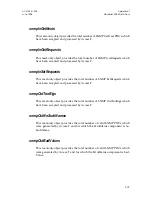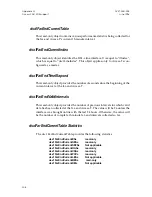
APPENDIX
SNMP Trap Support
H
Access-T supports both SNMP generic and enterprise-specific traps. Traps are
“autonomous” (i.e., unsolicited) messages used to report specific conditions or
events that occur at an SNMP agent, such as Access-T. A special code and textual
description identify each alarm and status. The SNMP manager interprets this
information and takes the appropriate action.
To communicate to slave units on the chain using SNMP, you must make sure that the
master unit has polling enabled for that slave and that the proper SNMP parameters
are enabled on the master as well as the slave.
Note 1
: SNMP trap support and automatic-dial-out alarm
notification are separate features. The method used for alarm
reporting is user-selectable. However, the Access-T alarm
must be enabled to generate an SNMP trap.
Note 2
: Only one trap manager is supported at one time. If no
IP address is assigned for a trap manager, trap messages are
disabled. The destination UDP port is fixed at 162, the standard
UDP port for receiving traps.
The process of dialing out to report alarms is not mandatory with Access-T. If
the current connection is SLIP or PPP, traps are sent immediately if the unit has
determined that it is talking with the trap manager (unit has already received
an IP packet from trap manager). If the current connection is TABS/UI, traps
are suppressed until a SLIP or PPP connection is established or until the next
opportunity to dial out arises.
In a chain configuration, slave which fail to respond to the master’s polls will
cause a trap specifying the slave as the problem source, even though the alarm
is generated by the master. If the slave’s IP address is unknown, a trap will not
be generated.
ACST-0351-005
Appendix H
June 1996
SNMP Trap Support
H–1
















































